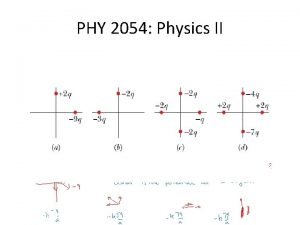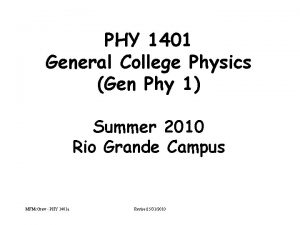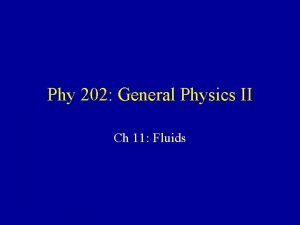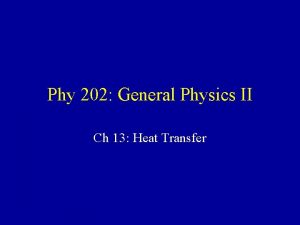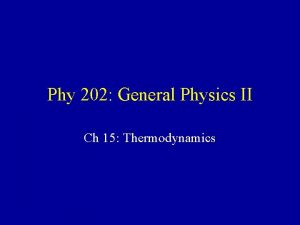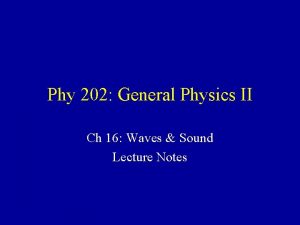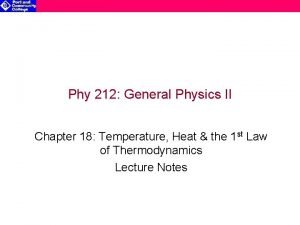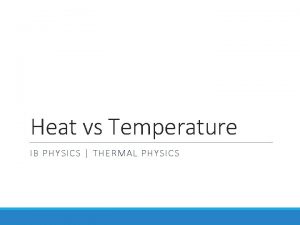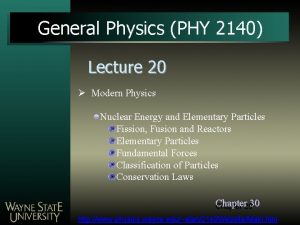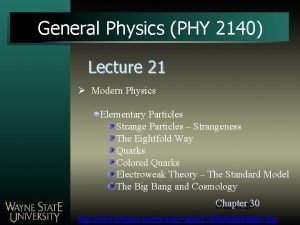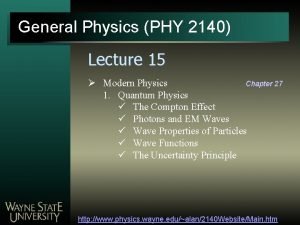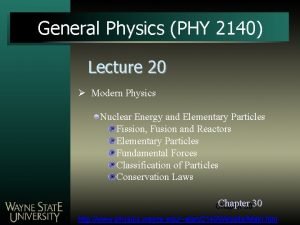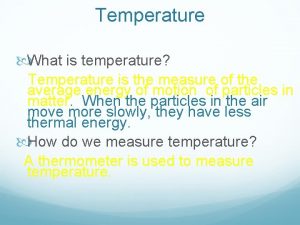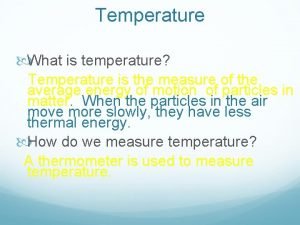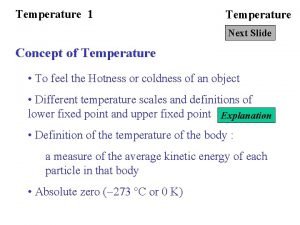Phy 202 General Physics II Ch 12 Temperature

















- Slides: 17

Phy 202: General Physics II Ch 12: Temperature & Heat

Joseph Black (1728 -1799) • English chemist • (re-)discovered carbon dioxide (“fixed air”) • Founder of calorimetry technique • Proposed a theory of heat that did not reference phlogiston, including: – The heat equation – Specific heat capacity & Latent heat • Widely renowned as a great teacher: "Many were induced, by the report of his students, to attend his courses, without having any particular relish for chemical knowledge. "

What is Temperature? • Temperature (T) is a measure of how “hot” or “cold” something is • Temperature is not energy nor is it heat (more on this later) • Temperature is a measure of the motion (vibration or translation) of the atoms/molecules that make-up an object – The greater the motion/vibration the greater the T – The smaller the motion/vibration the lower the T • Temperature is measured in 3 common scales: – Fahrenheit (USCS), o. F – Celsius or Centigrade (Metric), o. C – Kelvin (SI), K {note: units of Kelvin are not degrees K (or o. K), just K}

The Common Temperature Scales • Fahrenheit & Celsius • Celsius & Fahrenheit

Absolute Zero (0 K)

Linear Thermal Expansion • Most solid materials expand or contract depending on their temperature: – As T increases object expands – As T decreases object contracts • This is referred to as linear thermal expansion

Linear Thermal Expansion (cont. ) • The extent to which something expands/contracts with temperature (DL) depends on: – the physical properties of the material (a property called the coefficient of linear expansion, or a) – the original length of the object (Lo) – The increase/decrease in temperature (DT) in o. C or K units DL = a. Lo. DT {a is measured in units of o. C-1 or K-1, since DT is the same for both scales}

Thermometers • Thermometers are devices used to measure temperature • Measure a physical property that is temperature dependent – Length (linear thermal expansion) – Volume (volume thermal expansion) – Resistivity • Most common thermometers are based on linear thermal expansion (The mercury thermometer)

Volume Thermal Expansion • Objects will expand in volume as well as in length • Volume thermal expansion is analogous to linear thermal expansion: DV = b. Vo. DT • The coefficient, b, is called the coefficient of volume thermal expansion & is related the coefficient of linear thermal expansion (a) b = 3 a • Not only do solid objects expand/contract with temperature but so do holes within them!

Consider a “square” hole in a solid body • Think of the solid body as a collection of connected solid cubes • The small cubes each expand with increased temperature, which expands the hole in the middle • If a block (same size as the original hole) is heated to the same (higher) temperature it will fit perfectly in the hole The hole expands/contracts as if it were a solid body of that material!

Heat & Internal Energy • Heat is energy that flows from a high temperature object to a lower temperature object – When something absorbs heat its internal energy (or the energy of its atoms/molecules) increases – When something releases heat its internal energy decreases • The SI units of heat are joules (J) • Two things occur when an object absorbs or releases heat energy (Q): – The temperature will change (which is why they expand/contract, due to changes in molecular motion) – The object (or part of it) will change phase (solid, liquid, gas)

Heat & Temperature Change • When an solid (or liquid) of mass, m, absorbs and no phase change occurs: Q = c. m. DT {Black’s Heat Equation} Q is heat absorbed/lost, DT is the temperature change, and c is called the specific heat capacity • Specific Heat Capacity: – A physical property that relates how energy absorbed reflects changes in temperature for a given substance – In SI terms: the amount of energy required to change the temperature of 1 kg of a substance by 1 o. C (or 1 K) – SI units for specific heat capacity are J/(kg. K) – Metals tend to have low specific heat capacities (which is one reason they make great cooking vessels) – Non-metal substances tend to have higher specific heat capacities – Water has an unusually high specific heat capacity

The Mechanical Equivalent of Heat • Before it was established that heat was indeed energy, heat was traditionally measured in units of calories (cal): – 1 calorie = amount of heat required to raise the temperature of 1 g of water by 1 o. C • James Prescott Joule established that heat energy is the equivalent of mechanical energy: 1 cal = 4. 186 J • In nutrition we often invoke the kilocalorie (or nutritional calorie): 1 kcal = 1 Cal = 1000 cal = 4186 J • The “typical” person needs to eat ~2000 Cal daily (or 2 x 106 cal of food energy)

Calorimetry • A method to measure specific heat capacity that is based on: – The principle of conservation of energy – The known specific heat capacity for water (1000 cal/kg. o. C or 4186 J/kg. o. C ) • The Process: • A heated object is placed into a thermally isolated container containing a known amount of water Qnet = Qgained by water + Qgained by object = 0 • Object and liquid reach thermal equilibrium: Qgained by water = Qlost by object {= - Qgained by object} • The final temperature of the object/water is used to determine the specific heat of the object

Typical Calorimetry Problems • An unknown object of known mass (e. g. 0. 10 kg) is heated to a known temperature (e. g. 90. 0 o. C) then placed in a thermally isolated container (the “calorimeter”) containing a known mass (say 0. 10 kg) of cold temperature (e. g. 15. 0 o. C) water. – If the final temperature of the water/object is 22. 5 o. C, what is the specific heat capacity of the object? – What is the substance made of? • An object of known specific heat (e. g. gold) and mass (e. g. 0. 15 kg) is heated to a known temperature (e. g. 95. 0 o. C) then placed in a thermally isolated container (the “calorimeter”) containing a known mass (say 0. 10 kg) of cold temperature (e. g. 15. 0 o. C) water. – What is the final temperature of the object/water?

Heat & Phase Change • When a substance absorbs/loses heat energy its temperature will change until: – the substance reaches its “critical” temperature it will no longer change temperature – gain/loss of additional heat energy will also result in the phase transformation of the matter from one phase to another: Solid ® liquid ® gas • The relationship that describes heat energy (Q) gained/lost to mass of substance (m) that undergoes a phase change is: Q = m. L L is called the latent heat (the SI units are J/kg) • Latent heat is a physical property that describes how much energy is required to transform the mass of a substance from one phase to another (e. g. latent heat of fusion or vaporization, etc. )

Heat vs. Temperature Graph (for water) Examples of Phase Change Question: So why do you feel so “cold” when you step out of the shower soaking wet?


















